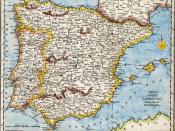If "revolutionary movement" is defined as a social movement dedicated to changing the power or the organizational structures by an independence movement, and if "most" is defined as greatest, "successful" as a desired outcome and "original rationale and/or purpose" is defined as an fundamental intentional reason, then between the countries of Brazil and Mexico, Brazil had the most successful revolutionary movement in terms of its original rationale and/or purpose because Brazil, unlike the Mexican independence movement, had a greater universal agreement about independence between every social class, Brazil was politically stable after independence and it was economically stable after independence.
Before Mexico gained independence from Spain it had multiple social classes, all of whom had different motives before it began. The Mexican Independence was sculptured by the tension between the Peninsulares, who composed 0.2% of the population, and the Creole, who comprised 17.8% of the population. The Peninsulares, were the Spanish born Spaniards of Mexico, and the Creole unlike the Peninsulares, were Mexican born Spaniards (Bethell 54).
The rest of the populations were lower class citizens that were 60% Indian, and 22% mixed (Bethell 55). Once Napoleon invaded the Iberian Peninsula on 1808 on July 16, dethroned Ferdinand VII and put his brother at the throne, the alliance that was forming between the Creole bourgeoisie and property-owning elite broke up in the immediate wake of the collapse (Bethell 58). "Jose Primo Verdad and Juan Francisco Azcarate, a friar from Peru, adopted a resolution on July 15 calling upon the viceroy, Jose de Iturrigaray, to assume direct control of the government in the name of Ferdinand VII and the representatives of the people" (Bethell 58).
Although a similar case is present in Brazil there is a slight difference. Through Brazil's system of clientele and patronage, middle class and lower...


